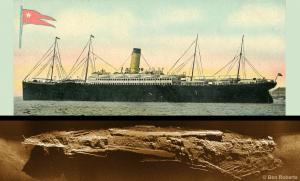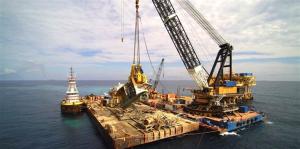The G.O.A.T., the Greatest Of All Treasures, Remains Entombed in the 1909 Shipwrecked White Star Liner RMS Republic
Lords Of Fortune Releases its Expanded Report on a 45 Ton Tsarist State Bank Shipment of US Gold Eagle Coins, a Treasure by Itself Exceeding $7 Billion
That’s 45 tons of US gold coins. That makes us the G.O.A.T., the Greatest Of All Treasures. We will be the largest treasure recovery of all time, bar none!”
MIAMI BEACH, FLORIDA, USA, August 30, 2023/EINPresswire.com/ -- Lords of Fortune LLC today released its updated and greatly expanded research report RMS Republic, Cargo: Russian State Bank Shipment, authored by Capt. Martin Bayerle. “For years, I had focused all my research efforts on Republic’s oft-quoted cargo of $3 million in American Gold Eagle coins. That cargo was also the subject of my 2013 book The Tsar’s Treasure, and my 2016 History Channel nine-episode series Billion Dollar Wreck,” Bayerle said. In 2017, Bayerle came into information suggesting that the reported $3 million Russian State Bank shipment was only a part of a much larger $25 million shipment, today estimated to exceed $7 billion.— Capt. Martin Bayerle
“This August we uncovered bank records which confirm our hypothesis and explain the transaction. In brief, the Russian State Bank redeemed $25 million in its 1904 War Bonds which Russia had issued to fight the Japanese. Those bonds matured in 1909. $25 million face-value in 1909 bearer bonds replaced the 1904 bonds. The 1909 bonds were sold on Wall Street at a discounted price of $22 million. The $3 million balance owed to the 1904 bondholders was paid in cash. That’s where the reports of Republic's oft-quoted $3 million cargo originated. $3 million was only a part of the $25 million Russian State Bank shipment,” He continued, “That’s 45 tons of US gold coins. That makes us the G.O.A.T., the Greatest Of All Treasures. We will be the largest treasure recovery of all time, bar none!”
RMS Republic was a 570-foot long, 15,000-ton White Star Line luxury liner that sank in January 1909 after leaving from New York for Europe, carrying many wealthy passengers and their baggage, thousands of sacks of mail, a large shipment of US Navy supplies (including a payroll for 16,000 sailors), as well as an only-rumored shipment of $3 million in U.S. gold coins. The ship was T-boned in very dense fog by an incoming Italian immigrant ship, the SS Florida, in the early morning hours of January 23, 1909, about 50 miles south of Nantucket, Massachusetts. She stayed afloat for 39 hours after the collision, allowing all passengers to transfer to other vessels via lifeboats and enough time for tug boats to begin towing Republic back to the U.S. coast for repairs. Passengers were told to hold onto their stateroom keys and they could retrieve all their belongings once the injured ship was safely back in port. However, the Republic didn’t make it. The “unsinkable ship” slipped beneath the waves on the way back with all cargo and passenger belongings still on board. At the time, RMS Republic was the largest ship to sink in history until she would be surpassed 3 years later, in 1912, by another unsinkable luxury White Star Liner, Titanic. However, what was the end of Republic’s story as a reliable luxury liner transporting wealthy passengers and cargo transformed into the beginning of another one - that of a lost sunken shipwreck containing, as one treasure book author put it, “riches beyond most men’s wildest dreams.”
Republic soon became a hot topic among salvage outfits of the time, but at 270 feet below the surface she was, at the time, technologically out of reach. The Titanic was lost in 1912. World War I, the 1917 overthrow by the Bolsheviks of the Tsarist Government, and the Great Depression soon followed; the Republic’s rumored cargo, except in treasure lore, soon faded from history.
While the physical recovery of the cargo was impossible until the 1960s, and, even today remains technologically daunting, research was the greatest challenge, in solving the mystery. Enter Martin Bayerle, who sought to locate the wreck, found her in 1981 and has been digging through archives all over the world and piecing together the details ever since. What kept the cargo in place was primarily the secrecy regarding the specifics of her cargoes, and the original government ownership interests. The Tsarist Government had ceased to exist in 1917, and the Bolsheviks soon repudiated all Tsarist debt. “There was simply no Government with whom to contract a salvage, and the British, French, and Americans were not going to give the Bolsheviks this gold, gold acquired from their sale of repudiated, now worthless Tsarist bonds,” said Bayerle.
The US Government litigated with Bayerle’s company for over a decade claiming that it owned “all” the gold aboard. “We have also proven a 1909 $800,000 US Navy shipment, today's value at about $200 million. And the US Government ended up with a subrogated interest in the Tsarist gold. When the Bolsheviks repudiated Tsarist debt in 1918, the US Government bailed out the New York banks and investors who had purchased Tsarist bonds; the ownership then fell to them. The problem for the US Government is that, shortly after they had recognized the Soviet Union in 1933, they then paid themselves from seized Tsarist assets, assets which the US Government had frozen in 1918. So, the US Government couldn’t double dip into Republic’s gold,” Martin Bayerle said. The US Government’s claim has since been dismissed with prejudice and, in 2011, Bayerle’s company was awarded legal title to the wreck and all of her cargoes by the U.S. District Court in Boston. All future claims were also barred by the Court.
"There's even more on the ship than what we've identified. The next step is to remove several thousand tons of collapsed decks and debris on top of where we believe the gold to be,” remarks Bayerle. "A minimum of $6.5 million is needed to reach the gold chamber. The total expense is expected to fall in the range of $20-25 million. But once gold is seen, on a $10 billion cargo, we can debt finance any amount needed to complete the recovery. If we could make a business case and decided, then, to raise the entire ship at a cost of $400 million, even that would be possible.”
“We’re looking for the right partners to structure a deal. We’ll let the market determine our current valuation, " said Bayerle.
Martin Bayerle
Lords of Fortune LLC
+1 772-494-6900
inquiries@LordsOfFortune.com
Visit us on social media:
Facebook
Twitter
LinkedIn
Legal Disclaimer:
EIN Presswire provides this news content "as is" without warranty of any kind. We do not accept any responsibility or liability for the accuracy, content, images, videos, licenses, completeness, legality, or reliability of the information contained in this article. If you have any complaints or copyright issues related to this article, kindly contact the author above.



